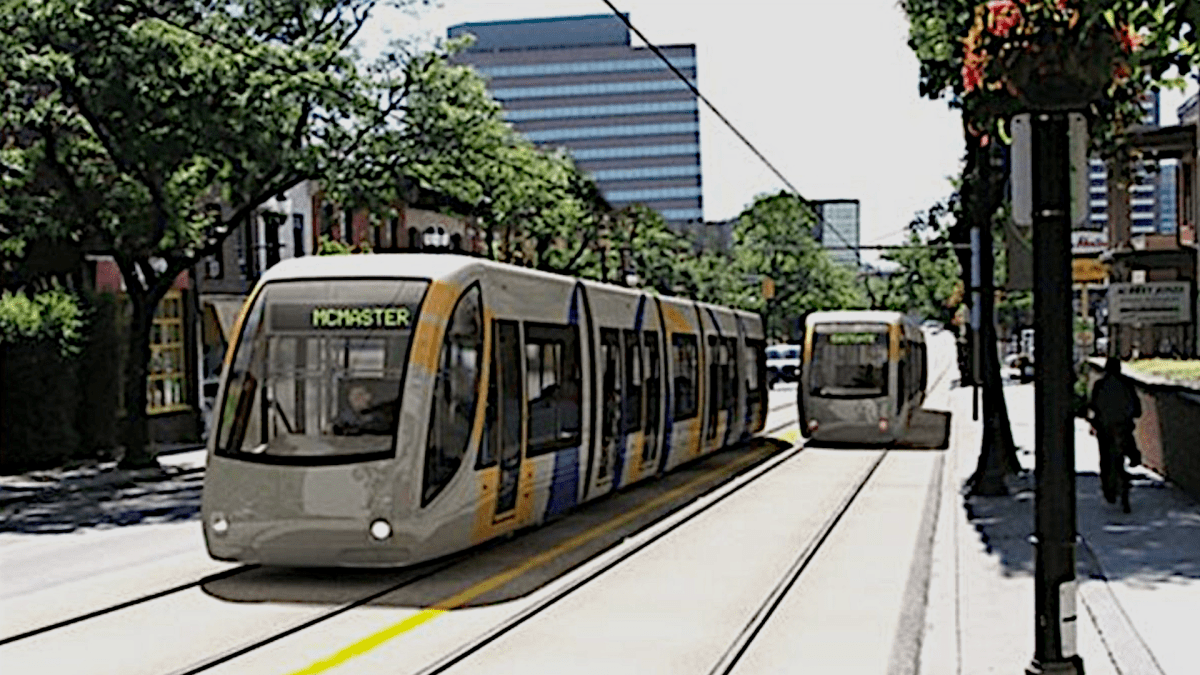Ontario is set to pitch a Hamilton light rapid transit (LRT) project as one of five priority Greater Toronto Hamilton Area (GTHA) transit projects to the federal government for funding.

A release from the Ministry of Transportation (MTO) confirmed they will be submitting proposals to the Investing In Canada Infrastructure Program (ICIP) Transit Program along with four Toronto based projects which include the Ontario Line, Yonge North Subway extension, Scarborough Subway extension and Eglinton Crosstown West.
The decision is based on a technical analysis from the Hamilton Transportation Task Force recommendations which resurrected the LRT possibility when suggesting it was the best option for spending $1 billion of funding from the province.
The five-member task force, formed in January 2020, presented a “higher-order transit project” which encompassed either a Light Rail Transit (LRT) system running east and west or Bus Rapid Transit (BRT) system that would run east and west in addition to routes north and south through the city.
The current LRT proposal from the province will ask for $1.5 billion from the federal government to cover the cost of building an estimated $2.5 billion LRT which is expected to run from McMaster University in the west to Gage Avenue in the east.
“We’ve determined that the best way to deliver an LRT option, which is we think optimal for the city of Hamilton, is to do that with a federal partner,” transportation minister Caroline Mulroney told Global News.
“So we’re putting forward an application to the federal government for federal funding, and I hope that today’s announcement will get them to the table.”
The minister did not reveal a timeline for when the project would start or end.
Mulroney suggested 9-kilometre route being proposed is also not set in stone.
Metrolinx, the province’s transit agency, is examining an 11 kilometre run from McMaster to Queenston Road as well as a 14-kilometre route from McMaster to Eastgate.

Get daily National news
“The ultimate alignment will depend on the support that we get from our partners,” said Mulroney.
“So that’s why it’s important that we reach out to the federal government at this point as we’re developing our plan to get them to the table.”
In August, the head of the Labourers’ International Union of North America (LiUNA) Joe Mancinelli told Global News the union pitched a $3.4-million LRT construction plan that would combine private money with potential contributions from the provincial and federal governments.
On Tuesday, the minister said the province could engage commercial partners and the city but said a long-term relationship with the federal government is of paramount importance.
“It still is very early, and we do need to get the federal government to the table with us so that we can discuss how we can deliver a longer and more viable and optimal LRT for Hamilton,” Mulroney said.
Ontario cancelled Hamilton’s 17-stop LRT in December 2019 claiming that the former Liberal government under Kathleen Wynne was not upfront about the true cost of the project.
A third-party analysis from Turner and Townsend in late 2019 pegged the project at an estimated cost of $5.5 billion — a price that Mulroney said the province simply “couldn’t afford.”
The decision was later backed up by the province’s auditor general (AG) Bonnie Lysyk, who said her office looked through numbers between 2016 and 2018 and found estimates “did not represent” the full cost of the LRT and suggested the numbers were “significantly understated.”
Former transportation minister and current Ontario Liberal leader Steven Del Duca characterized the Ford government’s announcement on Tuesday as a “flip flop” back to a “scaled back” version of an LRT project.
“With his eyes on the 2022 election, Doug Ford is cynically holding the Hamilton LRT hostage with a $1.5 billion ransom, which he hopes to collect from the federal government,” DelDuca said in a statement.
“Federal contributions are welcomed, but let’s be clear – the project had already been approved with provincial funding before he pulled the rug out from under Hamilton’s feet.”
Meanwhile, NDP leader Andrea Horwath suggested the Ford governments “cancelling, stalling, delaying, and changing” of the project has crushed small businesses that were counting the LRT.
“The Doug Ford government’s unilateral demand that the route end at Gage Avenue would cut out thousands and thousands of working folks and families in the east end who were counting on this LRT for work or school,” Horwath said in a statement.
So far, Metrolinx has spent about $162 million on the project already. Much of that related to the purchase of properties that the agency is still holding onto.
Canada’s Minister of Infrastructure Catherine McKenna told Global News in September that Ottawa was “committed to funding good public transit projects” and recognized the potential Hamilton LRT project as the “most shovel-ready” with local support.
Hamilton Mayor Fred Eisenberger said he welcomed the Ford government’s commitment to building Hamilton’s LRT.
“We have now rebounded from a cancelled project in December 2019 to a provincial priority project,” said Eisenberger in statement on Tuesday.
“However, for the LRT project to break ground, it would require federal participation. Based on that, we are cautiously optimistic.”







Comments